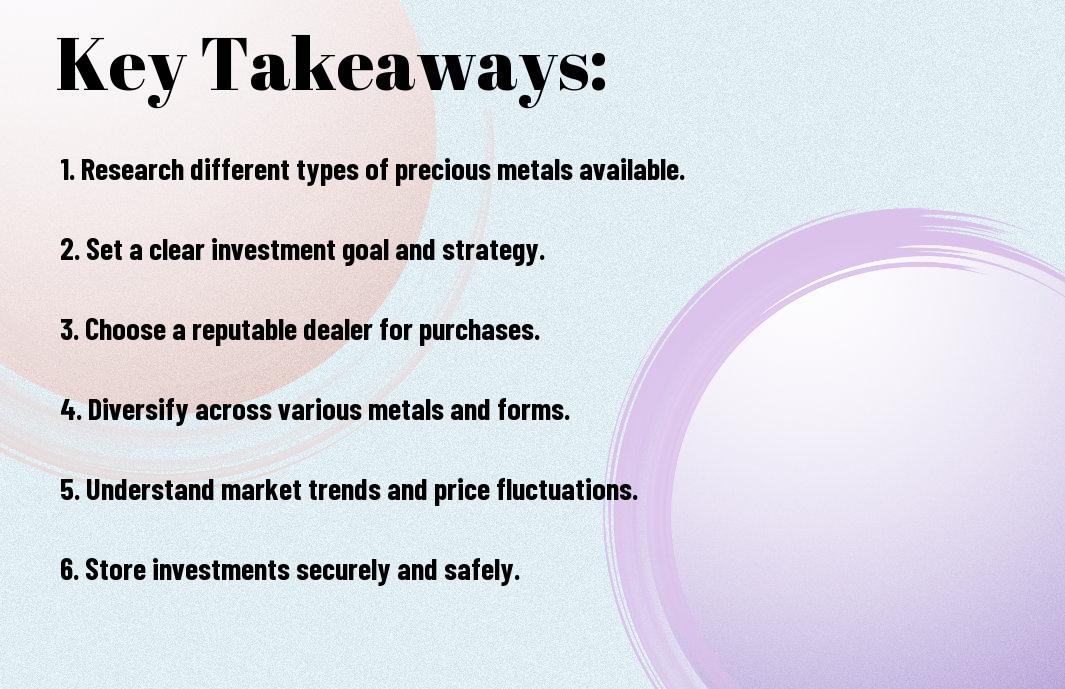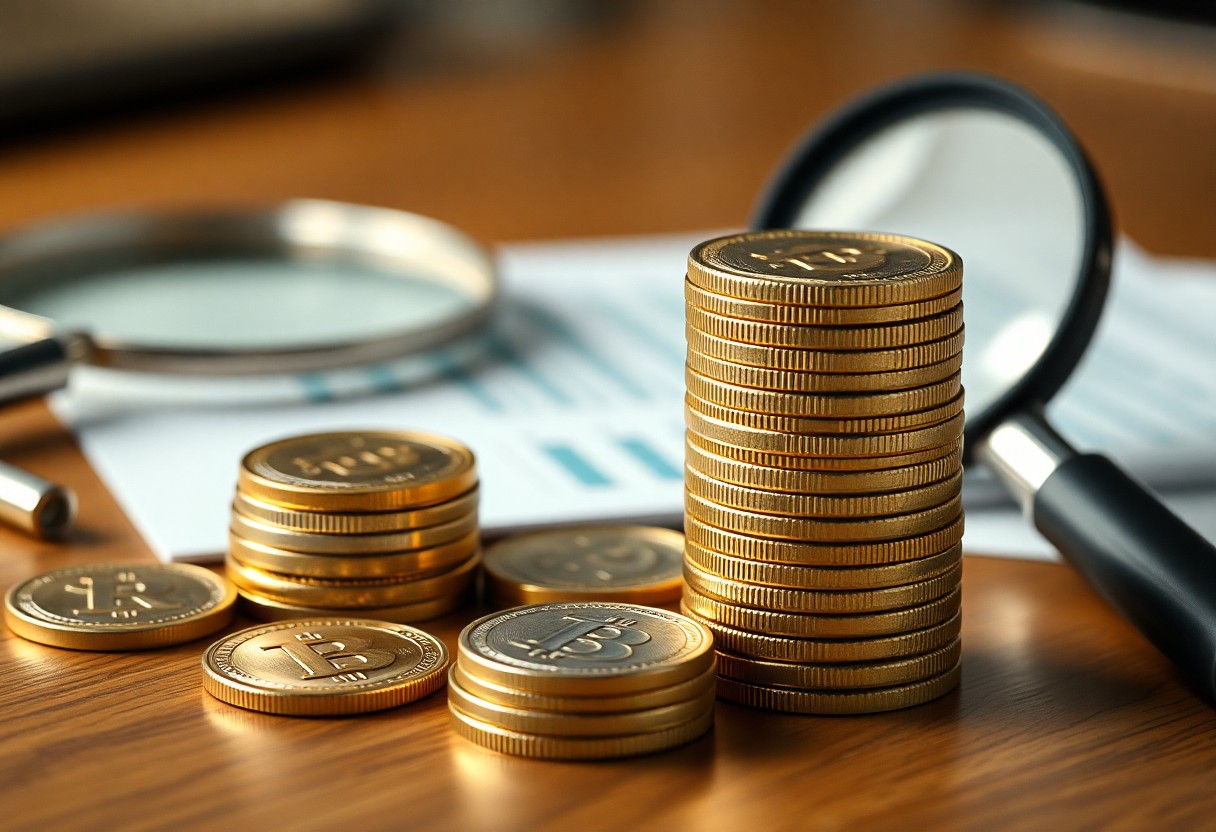Over the years, precious metals like gold, silver, and platinum have proven to be a reliable avenue for protecting and growing your wealth. If you’re looking to diversify your investment portfolio or hedge against economic uncertainty, understanding how to invest in these tangible assets is vital. This guide will walk you through the fundamental steps to start investing in precious metals, including how to research, choose your investments, and manage your portfolio effectively. By following these strategies, you can unlock the potential of precious metals in your financial journey.
Key Takeaways:
- Research the different types of precious metals such as gold, silver, platinum, and palladium to understand their market dynamics.
- Set a budget for your investment to determine how much you can allocate to precious metals without straining your finances.
- Select a reputable dealer or platform to buy precious metals, ensuring they have a solid track record and positive reviews.
- Decide on the form of investment, whether coins, bars, or ETFs, based on your investment goals and risk tolerance.
- Monitor the market trends regularly to make informed decisions about when to buy or sell your precious metals.

Understanding Precious Metals
A deep understanding of precious metals is necessary as you begin your investment journey. Gold, silver, platinum, and palladium have captivated investors for centuries due to their intrinsic value and historical significance. For insights on how to navigate this market, check out Investing in Gold and Silver: A Decision Guide.
Types of Precious Metals
About precious metals, you will find various forms that serve different investment purposes:
| Gold | Often viewed as a safe haven during economic downturns. |
| Silver | Used both as an investment and in industrial applications. |
| Platinum | A rarer metal, often associated with luxury items and industrial use. |
| Palladium | Gaining popularity for its applications in automotive and electronics. |
| Rhodium | Rarely traded but valued for its use in catalytic converters. |
- Gold
- Silver
- Platinum
- Palladium
- Rhodium
After familiarizing yourself with these types, you can make more informed decisions about your investments.
Benefits of Investing in Precious Metals
Among the many reasons to invest in precious metals, their role as a hedge against inflation and currency fluctuations stands out. These metals often retain value even when traditional investments decline, offering a reliable sanctuary for your assets.
Considering the unique position of precious metals in a diversified portfolio, they provide a sense of financial security, particularly in volatile markets. Their liquidity and tangible nature also make them a favored choice for investors seeking stability, ensuring that your investments are less susceptible to market swings.
Market Dynamics
It is imperative to understand the market dynamics of precious metals to make informed investment decisions. The prices of these metals are influenced by various factors, and being aware of these can help you strategize your investments effectively.
Factors Influencing Precious Metal Prices
Before investing, consider the numerous factors that influence precious metal prices, including:
- Supply and demand levels
- Geopolitical instability
- Inflation rates
- Currency strength
Knowing these elements can empower you to anticipate market movements and adjust your investment strategy accordingly.
Market Trends and Analysis
Among the various aspects to analyze, market trends play a significant role in shaping your investment approach. Keeping a close watch on historical price movements, industry developments, and economic indicators can provide valuable insights.
It is important to analyze patterns and trends over time to better gauge potential price fluctuations in precious metals. Factors like economic growth, changes in monetary policy, and technological advancements can create opportunities or challenges for investors. Regularly reviewing market analyses and expert opinions can equip you with the knowledge required to navigate the complexities of precious metal investments.
Ways to Invest
To begin your journey in precious metal investing, you have several options. Each approach comes with its own set of advantages and considerations. You can choose between direct ownership of physical metals, or you might prefer investing through financial products such as ETFs or stocks. Understanding these options will help you make informed decisions based on your investment goals.
Physical Purchase of Metals
Any investor looking to gain direct exposure to precious metals can opt for purchasing physical metals such as gold, silver, platinum, or palladium. This approach allows you to hold tangible assets in your possession, which can be stored securely at home or in a safety deposit box. While this method involves considerations regarding storage and insurance, it gives you peace of mind knowing you own the metals outright.
ETFs and Stocks in Precious Metals
Along with physical ownership, you have the option to invest in precious metals through exchange-traded funds (ETFs) or stocks in mining companies. These financial instruments offer a more liquid and potentially lower-risk approach to gaining exposure to precious metals without the need for physical storage.
A significant advantage of ETFs is that they typically track the price of specific metals, allowing you to invest in a diversified portfolio. Stocks in mining companies can offer higher potential returns; however, they also come with additional risks associated with business operations and market fluctuations. Whichever option you choose, it’s imperative to conduct thorough research and consider how these investments fit into your overall financial strategy.
Risk Management
Now that you understand the basics of precious metal investing, it’s vital to implement effective risk management strategies. Protecting your investments can ensure long-term success. For more insights on How to Invest in Precious Metals, exploring trends and potential market impacts is vital.
Assessing Risks in Precious Metal Investments
At the outset, assessing risks in precious metal investments involves evaluating factors such as market volatility, geopolitical instability, and economic shifts. Understanding these elements can help you anticipate fluctuations and make informed decisions that align with your investment goals.
Diversification Strategies
Metal diversification strategies are vital for spreading risk across various assets. By investing in a mix of precious metals like gold, silver, platinum, and palladium, you can mitigate the impact of market fluctuations on your overall portfolio.
Indeed, diversifying into related sectors, such as mining stocks or ETFs, can further enhance your portfolio’s stability and potential returns. This approach allows you to benefit from the performance of different metals and reduces the likelihood of significant losses should one market experience a downturn. By balancing your investments wisely, you ensure a more resilient portfolio that can weather market changes effectively.
Storage and Security
Once again, the security of your precious metals is a key consideration in your investment journey. How you store your investments can significantly impact their safety and value. You have various options, ranging from home safes to safety deposit boxes in banks. Each option comes with its advantages and disadvantages, so assess your situation carefully, considering factors such as accessibility, cost, and protection from theft or damage.
Safekeeping Your Precious Metals
Security is paramount when it comes to safeguarding your precious metal investments. Consider investing in a safe that is both fireproof and waterproof, ideally bolted to the floor or wall for added security. Furthermore, avoid disclosing the location of your metals to unauthorized individuals. Implementing a layered approach to security can significantly enhance the safety of your holdings.
Insurance Considerations
Between various storage options, it’s also wise to consider insuring your precious metals. Insurance can provide a financial safety net in case of theft, natural disaster, or other unexpected occurrences. By securing your investments with appropriate coverage, you can enjoy greater peace of mind while navigating the fluctuating world of precious metal investing.
This coverage not only protects you against potential losses but also allows for a smoother transition in case you decide to liquidate your assets. Before selecting an insurance policy, compare coverage options to ensure it aligns with the total value of your holdings. Additionally, keep an updated inventory of your precious metals to facilitate the claims process in case of an unfortunate event.

Tax Implications
Unlike other types of investments, precious metals can have unique tax implications that you should understand before diving in. Gains made from selling or trading these assets can be subject to capital gains tax, and various reporting requirements may apply depending on the type and value of your holdings. It’s vital to familiarize yourself with these regulations to ensure you remain in compliance and maximize your returns.
Reporting Precious Metal Investments
Around tax time, you will need to report your precious metal transactions to clarify your gains and losses. This process typically involves detailing any transactions over a specific threshold. Being organized and keeping thorough records will make this reporting straightforward, saving you potential headaches when tax season arrives.
Capital Gains Tax Considerations
Behind the scenes, capital gains tax plays a significant role in your overall investment strategy. This tax applies to profits realized from the sale of your precious metals and varies based on how long you’ve held the asset. Short-term capital gains tax rates may be higher than long-term rates, affecting your net return.
Reporting capital gains accurately involves calculating the difference between the purchase price and sale price of your precious metals. If you hold your investments for more than a year, you may qualify for lower long-term capital gains rates, making it beneficial to adopt a long-term investment strategy. Consulting a financial advisor or tax professional is wise to ensure you’re adhering to regulations and optimizing your tax situation.
Conclusion
To wrap up, starting your investment in precious metals involves research, setting a clear budget, and understanding market trends. You should identify which metals, such as gold or silver, align with your investment goals. Explore reputable dealers and consider both physical assets and investment vehicles like ETFs. It’s important to stay informed about market conditions and regularly review your portfolio. By taking these steps, you can make informed decisions that align with your financial objectives.
Q: What are the different types of precious metals available for investment?
A: When considering investment in precious metals, the primary options include gold, silver, platinum, and palladium. Gold is often viewed as a safe-haven asset and is widely recognized. Silver is also popular due to its relatively lower price and various industrial applications. Platinum and palladium are rarer and have unique uses in the automotive industry and other sectors. Investors may choose physical bullion, coins, ETFs, or mining stocks based on their investment goals and preferences.
Q: How do I set a budget for investing in precious metals?
A: Setting a budget for investing in precious metals involves assessing your financial situation and defining your investment goals. Analyze your overall financial health by looking at your income, expenses, and savings. Decide how much of your investment portfolio you want to allocate to precious metals, typically suggested to be between 5% to 10% for diversification. Lastly, specify the amount you are willing to spend on individual purchases, keeping in mind transaction fees and market fluctuations.
Q: What factors should I consider when choosing a dealer for my precious metals purchases?
A: When identifying a dealer for purchasing precious metals, consider their reputation, experience, and customer reviews. Look for dealers who are members of industry associations, such as the Professional Coin Grading Service (PCGS) or the American Numismatic Association (ANA). Assess the pricing structure, including premiums over spot prices, and ensure they provide a transparency regarding their fees. Additionally, evaluate their policies on shipping, returns, and storage options. A trustworthy dealer should also offer educational resources to ensure you make informed decisions.
